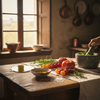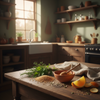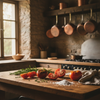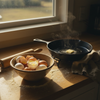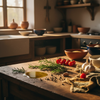Liquid Measuring Cup Guide: Choose the Perfect One
The Ultimate Guide to Liquid Measuring Cups: Precision Tools for Culinary Success
Ever stared at a recipe calling for exactly 3/4 cup of chicken stock and wondered if that drinking glass from your cabinet would do the trick? We've all been there. But here's the truth: in the kitchen, precision matters. And when it comes to measuring liquids, having the right tool isn't just helpful—it's essential for turning that ambitious recipe from Pinterest into a dish worth bragging about.
At DI ORO, we believe the difference between good cooking and great cooking often comes down to the details. And few details matter more than accurate measurements. That's why understanding liquid measuring cups—those clear vessels with the handy spout and measurement lines—deserves your attention if you're serious about upping your kitchen game.
What Makes a Liquid Measuring Cup Special?
A liquid measuring cup isn't just any cup—it's a precision instrument designed specifically for measuring fluid ingredients. Unlike their dry-measuring cousins (those stackable cups you level off with a knife), liquid measuring cups feature a pour spout, handle, and measurement markings that allow you to measure ingredients without spilling precious drops of vanilla extract or that fancy olive oil you splurged on.
The most distinctive feature? Space above the highest measurement line. This isn't wasted space—it's intentional design that prevents sloshing and spilling as you transport liquids from counter to stovetop. Genius, right?
Liquid vs. Dry Measuring Cups: The Showdown

You might be wondering: "Can't I just use one type of measuring cup for everything?" While nobody's going to revoke your home chef card if you do, understanding the difference between liquid and dry measuring cups will seriously elevate your cooking game.
The Fundamental Differences
- Design: Liquid measuring cups have a spout and handle, while dry measuring cups have straight edges for leveling.
- Measurement method: Liquid cups measure volume from the side, while dry cups measure to the rim.
- Accuracy: Using the wrong type can lead to measurement errors of up to 30%—enough to turn your perfect soufflé into a sad pancake.
Here's the science: Liquid ingredients need to be measured at eye level, observing the bottom of the meniscus (that curved surface liquids form). Try doing that with a dry measuring cup, and you'll either underfill it or create a wobbly dome of liquid just waiting to spill. Conversely, flour measured in a liquid cup can't be properly leveled, leading to inconsistent amounts.
Think of it this way: a dry measuring cup is like a precise container filled exactly to capacity, while a liquid measuring cup is like a measuring tool with built-in safeguards against the natural properties of liquids (like sloshing and surface tension). Both serve their purpose perfectly—when used correctly.
As America's Test Kitchen (who gave our spatulas top honors) has demonstrated repeatedly in their equipment tests, using the right measuring tool can make the difference between recipe success and a disappointing outcome. And nobody wants to waste good ingredients on a disappointing outcome. For more insights on achieving precision in your measurements, see this article by Allrecipes.
Anatomy of the Perfect Liquid Measuring Cup
Not all liquid measuring cups are created equal. When you're looking to add this essential tool to your kitchen arsenal, here are the features that separate the good from the great:
Material Matters
Glass, plastic, or metal? Each has its pros and cons:
- Glass: The gold standard. Durable, doesn't absorb odors or stains, microwave-safe, and won't leach chemicals into your food. The downside? It's heavier and can break if dropped.
- Plastic: Lightweight and shatterproof, but may absorb odors over time and can stain when measuring ingredients like tomato sauce or turmeric. Look for high-quality, BPA-free options if you go this route. Check out our Lemon Dill Yogurt Sauce recipe for a delicious way to use your newly acquired measuring skills.
- Metal: Rare for liquid measuring cups (more common for dry), but some stainless steel options exist. Durable but not microwave-safe and sometimes harder to read measurements on.
At DI ORO, we're sticklers for food safety—it's why our silicone products are forever-chemical free and LFGB certified. When choosing measuring cups, we recommend applying the same high standards. What touches your food matters, whether it's a spatula or the cup measuring your ingredients.
Readability: The Unsung Hero
Clear, easy-to-read measurements make all the difference when you're in the middle of cooking. The best liquid measuring cups feature:
- High-contrast markings that don't fade over time
- Multiple measurement scales (cups, ounces, milliliters)
- Markings that can be read from above and at eye level
- Clear indicators for common recipe amounts (1/4 cup, 1/3 cup, etc.)
Pro tip: If you find yourself squinting or second-guessing measurements, it's time for an upgrade. Your recipes (and eyes) will thank you. For a comparison of the best measuring cups available, visit Serious Eats.
Ergonomics: Because Comfort Counts
A comfortable handle might seem like a luxury until you're pouring hot chicken stock into a simmering risotto. Look for:
- Heat-resistant handles that stay cool
- Ergonomic design that provides a secure grip
- Balance that prevents tipping when the cup is partially filled
- A smooth-pouring spout that minimizes drips and spills
These features aren't just about comfort—they're about control. And in cooking, control translates directly to confidence and better results. For a comforting meal, try our Kale Egg Bake.
The Perfect Pour: Technique Matters

Even the best liquid measuring cup requires proper technique. Here's how the pros do it:
- Place your measuring cup on a flat surface.
- Pour your liquid in, getting close but not quite to your target measurement.
- Bend down to view the measurement at eye level (not from above).
- Look for the bottom of the meniscus—the curved surface of the liquid—to align with your measurement line.
- Add or remove liquid as needed to hit your mark precisely.
This technique might seem fussy, but it becomes second nature quickly. And the payoff in recipe consistency is absolutely worth it. After all, if you're going to put your heart into cooking, why not aim for perfection?
Popular Liquid Measuring Cup Options: Finding Your Perfect Match
When it comes to liquid measuring cups, the market offers everything from budget-friendly basics to professional-grade precision tools. But as we always say at DI ORO, investing in quality kitchen tools isn't an expense—it's an investment in your culinary future. Let's explore the options that will help you measure with confidence and cook with heart.
Glass: The Classic Choice
Glass measuring cups have earned their place in kitchens worldwide, and for good reason. The gold standard here is undoubtedly Pyrex, whose 3-piece glass measuring cup set has been helping home chefs nail their measurements for generations. These workhorses feature clear tempered glass that stands up to hot liquids, microwave use, and years of dishwasher cycles without losing their clarity or accuracy.
What makes glass measuring cups so beloved is their stability. Place one on your counter, and it stays put as you pour in that chicken stock or cream. The non-porous surface won't absorb flavors or colors, meaning your morning smoothie won't taste faintly of last night's garlic marinade. Now that's a win!
But glass isn't perfect (what is?). It's heavier than plastic alternatives and can break if dropped on a hard surface. And while that heft provides stability, it can make pouring from a full 4-cup measure a bit of a bicep workout—especially when precision matters. For a unique recipe, consider our Chicken Autumn Veggie Stuffed Acorn Squash.
Plastic: Lightweight Convenience
Don't dismiss plastic measuring cups too quickly. Today's high-quality options are miles beyond the flimsy, hard-to-read versions of yesteryear. Modern plastic measuring cups often feature:
- BPA-free, food-safe construction
- Flexible, squeezable sides for controlled pouring
- Lightweight design that won't weigh down your kitchen drawer
- Shatterproof durability (a blessing for those of us who've dropped a glass measure on tile)
Brands like OXO have revolutionized plastic measuring cups with their angled design, allowing you to read measurements from above—a game-changer when you're in the middle of a cooking frenzy. No more bending down to eye level! Just be aware that plastic may stain over time (tomato sauce, we're looking at you) and can absorb odors from strong-flavored ingredients. For more options, visit Food & Wine's review.
Finding the Right Size: From Teaspoons to Quarts

One liquid measuring cup isn't enough for a well-equipped kitchen. Just as DI ORO offers different spatula sizes for different tasks, measuring cups come in various capacities to handle everything from a splash of vanilla to quarts of soup stock.
The Essential Three: 1-Cup, 2-Cup, and 4-Cup Measures
For most home cooks, a set of three liquid measuring cups covers nearly every recipe requirement:
- 1-cup measure: Perfect for smaller quantities where precision is crucial—think vanilla extract, lemon juice, or that expensive olive oil. The smaller size allows for greater accuracy.
- 2-cup measure: The everyday workhorse for everything from measuring milk for pancakes to broth for risotto.
- 4-cup measure: Your go-to for larger recipes, soups, and batch cooking. Nothing's more frustrating than measuring 4 cups of liquid one cup at a time!
Pro tip: If budget constraints mean choosing just one, go for the 2-cup measure. It's versatile enough to handle most recipes without being unwieldy for smaller measurements or too limited for larger ones.
Specialty Sizes: When to Go Bigger (or Smaller)
Beyond the basic three, specialty measuring cups can make specific cooking tasks easier:
- Mini measures (1/4 cup or smaller): Ideal for precise small-quantity ingredients like extracts or flavorings.
- 8-cup measures: Perfect for serious soup makers, sauce masters, or anyone who regularly cooks for crowds. For a crowd-pleaser, try our Sub in a Tub Recipe.
- Adjustable measures: These clever tools feature a movable plunger that adjusts to different volumes—handy for small kitchens where storage space is at a premium.
Just like having the right DI ORO spatula for each cooking technique elevates your kitchen game, having the right-sized measuring cup for each task makes cooking more enjoyable and precise.
Liquid Measuring Techniques: The Art of Precision
Even America's Test Kitchen-approved tools require proper technique. Here's how to level up your measuring game and achieve professional-level accuracy:
The Meniscus Method: Reading Liquid Measures Correctly
Remember high school chemistry? That curved surface that liquids form in containers is called a meniscus, and it's crucial for accurate measurement. Here's the technique that separates cooking novices from kitchen ninjas:
- Place your measuring cup on a flat, level surface (not in your hand).
- Pour liquid until it's close to your desired measurement.
- Bend down so your eyes are level with the measurement line (looking down from above distorts your view).
- Look for the bottom of the meniscus curve to align exactly with your measurement line.
- Add or remove liquid as needed until perfectly aligned.
This might seem fussy at first, but it quickly becomes second nature—and the difference in your cooking results will be noticeable. Precision isn't just for professional chefs; it's for anyone who wants their culinary creations to turn out right, every time.
Measuring Sticky Liquids: The Oil-First Trick
Ever tried measuring honey or molasses, only to watch half of it stubbornly cling to the measuring cup? Here's a pro tip that will change your baking life: spray or wipe your measuring cup with a thin coat of neutral oil before measuring sticky ingredients. The sticky liquid will slide right out, giving you accurate measurements and easier cleanup. It's these little kitchen hacks that make cooking with DI ORO tools such a joy—we're all about removing frustration and adding fun!
Care and Maintenance: Making Your Measuring Cups Last

Quality measuring cups should last for years, even decades, with proper care. Here's how to keep them in prime condition:
Cleaning Tips for Different Materials
- Glass: Generally dishwasher-safe, but hand washing prevents measurement markings from fading over time. Avoid extreme temperature changes that could cause thermal shock and cracking.
- Plastic: Check if dishwasher-safe (top rack only). For stained plastic, a paste of baking soda and water can work wonders. Avoid abrasive scrubbers that might scratch the surface and make measurements harder to read.
- Metal: Hand washing is best to preserve any printed measurements. Dry thoroughly to prevent water spots or potential rusting.
Just as we designed our DI ORO spatulas to be easy to clean and maintain (dishwasher safe, stain-resistant, and built to last), the best measuring cups are those that continue to perform beautifully year after year with minimal fuss.
Storage Solutions: Keeping Order in Your Kitchen
Nesting measuring cups save space, but can also lead to scratches if not handled carefully. Consider these storage options:
- Hang larger cups on hooks for easy access and to prevent scratching.
- Store in a dedicated drawer with dividers to prevent shifting and damage.
- For glass measuring cups, place a microfiber cloth between nested cups to prevent scratching.
Remember, your measuring cups are precision instruments—they deserve a storage solution that protects their accuracy and readability. After all, when you're in the middle of creating culinary magic, the last thing you need is to squint at faded measurement lines!
Features That Matter: What Makes a Great Liquid Measuring Cup
Let's get real for a moment. Not all liquid measuring cups are created equal, and if you've ever tried to pour pancake batter from a poorly designed one, you know exactly what I'm talking about. At DI ORO, we obsess over the details that make kitchen tools exceptional, and liquid measuring cups are no exception. Here's what separates the good from the great:
Readability: Clear Markings Make All the Difference
The best liquid measuring cups feature high-contrast, easy-to-read markings that won't fade over time. Look for bold lines with clear numbering—preferably in both imperial (cups, ounces) and metric (milliliters) measurements. Some brands like Pyrex and OXO use red markings against clear glass or plastic, creating that crucial contrast that makes reading measurements a breeze even in dim kitchen lighting or when measuring dark liquids.
Remember those America's Test Kitchen winners we mentioned? Their measuring cups earned top marks for markings that align perfectly with the meniscus, using arrows that guide your eye to exactly where you should be looking. It's these thoughtful design elements that elevate cooking from frustrating to fantastically fluid.
For those keen on exploring our premium selections, check out our award-winning collections.
The Perfect Pour: Spout Design Matters
A good spout is the unsung hero of the liquid measuring cup world. It should direct your liquid precisely where you want it—not dribbling down the side or splashing unpredictably. The best spouts feature:
- A defined "lip" that breaks the surface tension cleanly
- Sufficient width to allow smooth flow without gurgling
- A tapered design that prevents drips when you stop pouring
- Reinforced construction that won't chip or crack with use
Just like our DI ORO spatulas are designed with the perfect flexibility for scraping every last bit from your mixing bowl, the ideal measuring cup spout gives you complete control over your pour—whether you're adding a slow drizzle of cream to a simmering sauce or pouring batter into sizzling pan.
Handle Ergonomics: The Comfort Factor
You might not think about the handle of your measuring cup until you're pouring hot chicken stock and suddenly realize it's burning your fingers or slipping from your grip. Quality measuring cups feature handles that are:
- Heat-resistant, staying cool even with boiling liquids inside
- Ergonomically shaped to fit comfortably in your hand
- Sufficiently sized for a secure grip, even with oven mitts
- Balanced to prevent tipping when the cup is full
This attention to handle design is something we understand deeply at DI ORO. Just as our spatula handles are crafted for the perfect balance of comfort and control, a well-designed measuring cup handle transforms precision pouring from a precarious task to a pleasure.
Liquid vs. Dry Measuring Cups: Why You Need Both
I'll let you in on a little kitchen secret: using the right tool for the job isn't just about convenience—it's about accuracy. The difference between liquid measuring cups and dry measuring cups isn't just marketing; it's fundamental to how ingredients are measured correctly.
The Science Behind the Difference
Liquid measuring cups are designed for volume measurement of fluids, with room above the measurement line to prevent spills and allow for the meniscus to form. Dry measuring cups, on the other hand, are designed to be filled to the brim and leveled off, giving you a precise amount of dry ingredients like flour, sugar, or rice.
Think of it this way: if you tried to measure a cup of flour in a liquid measuring cup, you'd have no way to level it off properly. Conversely, if you filled a dry measuring cup with water to the brim, you'd likely spill it before reaching your mixing bowl. It's like trying to flip delicate fish with a serving spoon instead of a DI ORO fish spatula—technically possible, but not setting yourself up for success!
When to Use Each Type for Best Results
For kitchen confidence and recipe success, here's when to reach for each type:
- Use liquid measuring cups for: Water, milk, oil, honey, molasses, syrups, and any pourable ingredient
- Use dry measuring cups for: Flour, sugar, rice, oats, chopped vegetables, and ingredients you can level off with a straight edge
Pro tip: Some ingredients fall into a gray area. Peanut butter, for instance, is technically not a liquid but isn't easily leveled off either. For these in-between ingredients, I recommend using a dry measuring cup and using a flexible silicone spatula (like our award-winning DI ORO ones tested by America's Test Kitchen) to scrape out every last bit.
Building Your Kitchen Measuring Arsenal
Ready to upgrade your measuring game? Here's my recommendation for a complete measuring setup that will handle everything from quick weeknight dinners to ambitious weekend baking projects:
The Essential Measuring Cup Collection
For a well-equipped kitchen that's ready for any recipe, consider this lineup:
- Liquid measuring cups: A set of three glass cups (1-cup, 2-cup, and 4-cup) for durability and clarity, plus one angled plastic cup for quick measurements
- Dry measuring cups: A nested set of stainless steel cups (¼, ⅓, ½, and 1 cup) for dry ingredients
- Measuring spoons: A set that includes both standard (¼ tsp to 1 Tbsp) and odd sizes (⅛ tsp, ¾ tsp) for complete versatility
- Digital kitchen scale: For the ultimate precision, especially for baking or following European recipes
With this collection, you'll be equipped to tackle everything from precise baking measurements to free-flowing cooking estimates. Think of it as your measurement toolkit—each piece serving a specific purpose in your culinary creations.
Budget-Friendly Options That Don't Sacrifice Quality
Quality doesn't always mean expensive. Here are some smart investments that balance affordability with performance:
- Look for open-stock options to buy only the sizes you'll use most frequently
- Consider combo sets that include both liquid and dry measures for better value
- Check restaurant supply stores for professional-grade measuring tools at reasonable prices
- Invest in one high-quality glass measuring cup now, then add to your collection over time
Remember, just as DI ORO tools are designed to last and perform beautifully for years (backed by our lifetime warranty), investing in quality measuring cups means buying them once and enjoying them for countless recipes to come.
For those looking for exclusive kitchen tools, check out our limited-time offers.
Conclusion: Measure with Confidence, Cook with Heart
The humble liquid measuring cup may not be the flashiest tool in your kitchen, but it's certainly among the most essential. Whether you're measuring out the perfect amount of broth for risotto, precisely portioning cream for a delicate sauce, or simply making sure your morning coffee has the right ratio of water, accurate liquid measurement is the foundation of cooking success.
At DI ORO, we believe that great cooking comes from a combination of quality tools, proper technique, and the confidence to create boldly. Your liquid measuring cups—whether glass, plastic, or a combination of both—are silent partners in your culinary journey, helping transform your cooking from good to consistently great.
So next time you reach for that measuring cup, take a moment to appreciate this kitchen workhorse. Use it with the proper technique—flat surface, eye-level reading, respecting the meniscus—and watch how this small attention to detail elevates your cooking results. After all, cooking isn't just about feeding yourself; it's about creating moments, memories, and meals that bring joy to your table.
Now that you're equipped with everything you need to know about liquid measuring cups, we'd love to hear about your kitchen adventures! Share your cooking wins or measuring questions with us on social media, and remember: in the DI ORO kitchen, we measure precisely, pour confidently, and always cook with heart. Looking for a fresh recipe to try out your new measuring skills? Check out our A New Approach to Garlic blog post for inspiration.
Frequently Asked Questions
What is a liquid measuring cup?
A liquid measuring cup is a kitchen tool designed specifically for measuring liquid ingredients, such as water, milk, or oil. Typically made of glass or clear plastic, these cups often have pouring spouts and measurement markings on the side, allowing for precise measuring from the side rather than needing to fill to the brim.
Is 1 cup of liquid the same as 1 cup of dry?
While both liquid and dry measuring cups represent the same volume, 1 cup, they are designed for different substances. Liquid measuring cups allow you to pour and measure without spilling, while dry measuring cups can be leveled off for an accurate measure of dry ingredients like flour or sugar.
What can I use if I don't have a liquid measuring cup?
If you don't have a liquid measuring cup, you can use a standard kitchen measuring cup and carefully fill it to the desired amount, checking at eye level for accuracy. Alternatively, using a clear container with measurement markings, such as a graduated cylinder or even a mason jar with pre-measured lines, can help ensure precision.
How much is 1 cup of liquid?
1 cup of liquid is equivalent to 8 fluid ounces, or approximately 237 milliliters. This measurement is standard in the United States, where it's used for both cooking and baking recipes.
Is 1 cup 8 oz or 16 oz?
1 cup is equivalent to 8 fluid ounces in terms of liquid measurement. The confusion might arise because 16 ounces often refer to weight, but in the context of liquid measurement, a cup is always 8 fluid ounces.
How do you measure liquidy liquid?
To measure liquidy liquid, pour the liquid into a liquid measuring cup and view the measurement at eye level for accuracy. Ensure the cup is on a flat surface and avoid tilting it, as this can lead to an incorrect measurement, especially with more fluid or viscous substances.
